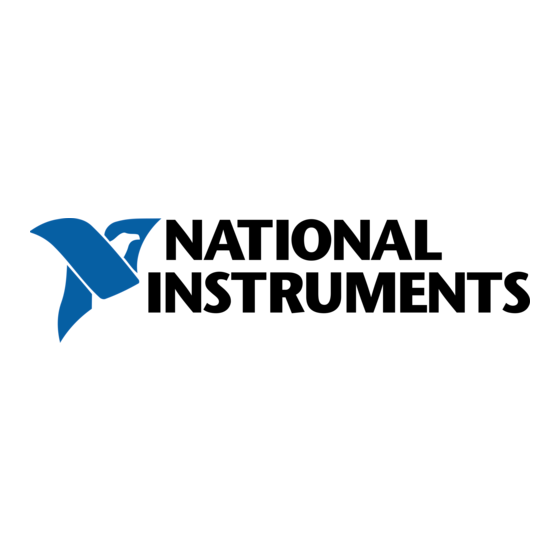
Table of Contents
Advertisement
Quick Links
Advertisement
Table of Contents

Summary of Contents for National Instruments SCC-PWR02
- Page 1 SCC-PWR02...
- Page 2 USER GUIDE SCC-LP Series Lowpass Filter Modules The SCC-LP Series lowpass filter modules contain fourth-order Butterworth filter circuitry. They accept two differential input signals within a ±10 V range. A differential amplifier attenuates each signal by a factor of two. The output of the amplifier passes through a fourth-order Butterworth filter circuit.
- Page 3 When symbol is marked on a product, it denotes a warning advising you to take precautions to avoid electrical shock. When symbol is marked on a product, it denotes a component that may be hot. Touching this component may result in bodily injury. bold Bold text denotes items that you must select in software, such as menu items and dialog box options.
-
Page 4: What You Need To Get Started
To set up and use the SCC-LPXX, you need the following items: ❑ SC-2345/2350 with one of the following: – SCC-PWR01 – SCC-PWR02 and the PS01 power supply – SCC-PWR03—requires a 7 to 42 VDC power supply (not included) ❑ One or more SCC-LPXX ❑... -
Page 5: Device Specific Information
Device Specific Information Note For general SCC module installation and signal connection information, and information about the SC-2350 carrier, refer to the SCC Quick Start Guide, available for download at ni.com/manuals Installing the Module Caution Refer to the Read Me First: Safety and Radio-Frequency Interference document before removing equipment covers or connecting/disconnecting any signal wires. - Page 6 Signal source may be floating or ground-referenced. Figure 1. SCC-LP XX Signal Connections For information about configuring the SCC-LPXX module using NI-DAQmx, refer to the SCC Quick Start Guide. © National Instruments Corporation SCC-LP Series Lowpass Filter Modules User Guide...
-
Page 7: Specifications
Using the SCC-LP XX when Scaling Voltage Measurements If you configured the SCC-LPXX using Measurement & Automation Explorer (MAX) and you are using NI-DAQ, the voltage reading you get from the E Series DAQ device accounts for the voltage scaling effect of the SCC-LPXX. -
Page 8: Filter Characteristics
Total harmonic distortion (THD) at fc ... < –90 dB Wide-band noise (DC to 1 MHz, RTI)....... 100 µV Narrow-band noise (DC to 33 kHz, RTI) ......6 µV Applicable at 25 °C. © National Instruments Corporation SCC-LP Series Lowpass Filter Modules User Guide... -
Page 9: Power Requirement
Stability Gain temperature coefficient ....10 ppm/°C typ 20 ppm/°C max Offset-voltage temperature coefficient ......3.4 µV/°C typ (RTI) 27 µV/°C max Power Requirement Analog power SCC-LP01, SCC-LP02 ....135 mW max +15 V........4.5 mA max –15 V ........4.5 mA max SCC-LP03, SCC-LP04 ....475 mW max +15 V........15.8 mA max –15 V ........15.8 mA max Digital power ..........0.0 mW max... -
Page 10: Electromagnetic Compatibility
To obtain the DoC for this product, visit , search by model number or product line, and click the ni.com/hardref.nsf appropriate link in the Certification column. © National Instruments Corporation SCC-LP Series Lowpass Filter Modules User Guide... -
Page 11: Theory Of Operation
Theory of Operation SCC-LP XX Performance The SCC-LPXX uses a Butterworth filter, which is characterized by maximal flatness in the passband with very sharp monotonic rolloff. It has a nonlinear phase response, the delay is not constant, and the step response exhibits a moderate amount of overshoot (ringing). - Page 12 20 25 Frequency (Hz) Figure 3. Typical SCC-LP02 Response Curve – 5.0 – 10.0 – 15.0 – 20.0 – 25.0 20 25 Frequency (Hz) Figure 4. Typical SCC-LP03 Response Curve © National Instruments Corporation SCC-LP Series Lowpass Filter Modules User Guide...
- Page 13 –5.0 –10.0 –15.0 –20.0 –25.0 3 4 5 1000 2000 Frequency (Hz) Figure 5. Typical SCC-LP04 Response Curve SCC-LP Series Lowpass Filter Modules User Guide ni.com...
- Page 14 –40 –60 –80 –100 0.10.15 1 1.5 Normalized Frequency (f/fc) b. Group Delay 0.15 Normalized Frequency (f/fc) c. Step Response Normalized Time (1/fc s) Figure 6. Theoretical Transfer Characteristics © National Instruments Corporation SCC-LP Series Lowpass Filter Modules User Guide...
- Page 15 The horizontal axes of the first two plots are normalized to the SCC-LPXX cutoff frequency. When the input frequency (f) equals the cutoff frequency (fc), the normalized frequency has a value of 1. The vertical axis of the third plot is normalized to the magnitude of the step input voltage.
- Page 16 25 Hz, you can calculate the minimum scan rate used by the E Series DAQ device to prevent aliasing—25 Hz × 20 = 500 samples per second per channel. © National Instruments Corporation SCC-LP Series Lowpass Filter Modules User Guide...
- Page 17 Calibrating Gain Errors The SCC-LPXX is calibrated at the factory before shipment. If you want to calibrate the SCC-LPXX in your system, you need a voltage source capable of providing a DC voltage up to ±10 V that is several times more accurate than the SCC itself.
- Page 18 Figure 8 shows the I/O connector pins on the bottom of the module. 1 Pin 1 Pin 2 PWB Key Pin 19 5 Pin 20 Figure 8. SCC Module Bottom View © National Instruments Corporation SCC-LP Series Lowpass Filter Modules User Guide...
- Page 19 *371071B-01* Corporation. Product and company names mentioned herein are trademarks or trade names of their respective companies. For patents covering National Instruments products, refer to the appropriate location: Help»Patents in your software, the patents.txt file on your CD, or ni.com/patents.









Need help?
Do you have a question about the SCC-PWR02 and is the answer not in the manual?
Questions and answers